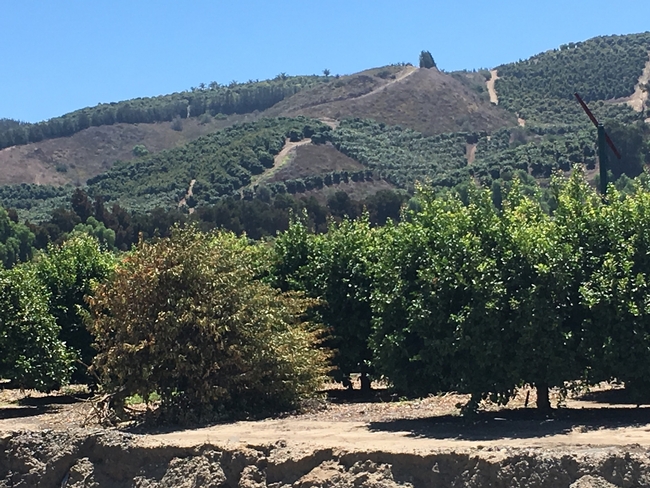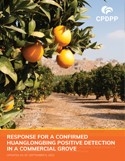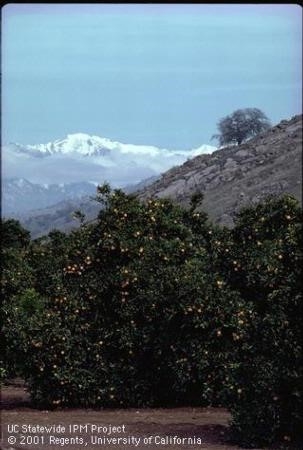UCR wages $11+ million war against citrus greening disease
Three projects win funding to fight tree-killing bacteria

International Research Conference on HLB
Here in California
The International Research Conference on Huanglongbing VII (IRCHLB VII) is just around the corner! The California citrus industry is excited to welcome researchers, regulators, and citrus industry members from around the world to the Golden State. Do not miss these key dates:
A hotel room block with special conference rates has been set aside near the convention center and is filling up quickly. Book your room today at the Historic Mission Inn Hotel & Spa.
For the conference agenda, please click here. To register and access more conference details, CLICK HERE..
This Conference has occurred every two years (except for the covid period). Check out the Proceedings from previous conferences!
The proceedings of the “International Research Conference on Huanglongbing” are available from the 2008, 2011, 2013, 2015, 2017, and 2019 conferences. Please use the following hyperlinks to access the proceedings.

IRCHLB 2023
Three projects win funding to fight tree-killing bacteria
With three new grants totaling more than $11 million, UC Riverside is helping lead the fight against citrus greening or Huanglongbing, a disease threatening citrus industries in the U.S. and worldwide.
The disease is from bacteria transmitted to citrus trees by a tiny flying insect, the Asian citrus psyllid. Infected trees produce no fruit, or fruit that is bitter, small and worthless. Despite intensive research for the past 15 years, there is no known cure for it. It has reduced citrus production in Florida by more than 75%, and it has already been detected in Texas and California.
Because California supplies the country with 80% of its fresh citrus, and because 267,000 acres of Golden State lemons, oranges, grapefruits, and mandarins are at stake if operations are permanently lost, the USDA National Institute of Food and Agriculture is making an emergency investment in citrus disease research with three projects at UCR.
These projects focus on instilling tolerance to the disease with three different approaches: below ground, in the rootstocks, above ground in the shoots and branches, and systemically, with a peptide that would move throughout the tree.
The largest of the projects, at $6.8 million, is being led by Danelle Seymour, assistant professor of genetics in the Botany and Plant Sciences Department at UCR. Their focus is on breeding Huanglongbing or HLB-resistant rootstocks, and the project depends on collaboration with Kim Bowman, a citrus breeder at the USDA Agricultural Research Service in Ft. Pierce, Florida.
“In Florida, nearly every single tree is infected. It's terrible for growers, but wonderful for breeding,” Seymour said. “We can't do this research at large scale in California because the disease isn't as widespread here.”
The classic way to improve resistance or encourage new qualities in crops is through genetics, making crosses between one plant that has a favorable trait, and one that doesn't. “We hope the result is better than the parents,” Seymour said. “When you work in wheat or tomato, you can do these crosses and perform evaluations every year. In citrus, it takes 10 - 15 years to evaluate a new generation of trees.”
Because of the long lag time, the research-ready trees in Florida represent an opportunity for Seymour's team to begin examining new crosses now. The breeder, Kim Bowman, has evaluated over 10,000 trees and unique hybrids, from which a handful will be selected for release to growers.
In addition to evaluating these select few new hybrids for their HLB tolerance, the researchers will be watching the Florida-grown trees' responses to the different environmental conditions in California. “Can they perform well in response to different salinity levels in the soil, different humidity, as well as other pests and pathogens that we have here? We'll find out,” Seymour said.
Chandrika Ramadugu, a project scientist also in UCR's Department of Botany and Plant Sciences, is leading a project to develop HLB-resistant scion varieties that can be grafted to rootstocks. A scion is an above-ground portion of a plant, such as a bud or shoot, that can be used for grafting.
For trees, grafting can be equated to an organ transplant. The scion from one tree is attached to the trunk or rootstock of another with the hope of creating a new plant with combined attributes.
With its grant of $3.28 million, this project will analyze second-generation hybrids that are bred for ten years using Australian lime as a source of disease resistance.
Ramadugu will evaluate 24 novel hybrids in California, Florida, and Texas to assess resistance to HLB. Ideally, in addition to having enhanced disease tolerance, the new plants will also be able to produce good-tasting fruit.
There is little genetic diversity in cultivated citrus. When new pathogens arrive, the genetic uniformity can result in disease epidemics and dire consequences for the crop. In addition to the potential benefits of this project for the fight against HLB, the new hybrids may also help protect citrus from other pests and pathogens.
A third project, granted $1.36 million, will utilize a peptide found in Australian finger limes that is known to impart HLB resistance. Led by Hailing Jin, Microbiology & Plant Pathology professor, the project is developing ways to infuse trees with the peptide.
“The antimicrobial peptide in the finger limes are more efficient at killing bacteria as compared to antibiotics currently used in the field, and much more stable at high temperatures,” Jin said.
Because spray applications are expensive, Jin's project aims to spread the peptide throughout the trees' insides. In collaboration with University of Florida professor Svetlana Folimonova, Jin's team utilizes a natural citrus virus with almost no symptoms to deliver the peptide into the trees.
“You infect the tree with the virus, and it will spread in areas where the bacteria reside,” Jin said. “It would move systemically through the tree, and it would be very cost efficient for growers. No need to buy more insecticides.”
These grants were enabled by the 2018 Agricultural Improvement Act, which authorized the Emergency Citrus Disease Research and Development Trust Fund to fight HLB. With these and other projects, the USDA is bringing together the nation's top scientists to find scientifically sound solutions to the problem in a financially and ecologically sustainable way.

hlb tree pulled
Seven entities recently received $21.7 million to conduct research into combating and preventing HLB at the farm level. The funding is from the U.S. Department of Agriculture's National Institute of Food and Agriculture (USDA NIFA) Emergency Citrus Disease Research and Extension program.

The University of Florida Institute of Food and Agricultural Sciences (UF/IFAS) received the majority of the funding, more than $16 million.
PROJECTS LED BY UF/IFAS
The largest grant, at approximately $8.6 million, is for development, evaluation and delivery of citrus HLB management approaches by targeting its nature as a pathogen-triggered immune disease. The principal investigator is Nian Wang. The goal is to develop HLB management approaches for existing groves and non-transgenic HLB-resistant and HLB-tolerant citrus varieties.
Other UF/IFAS projects are:
PROJECTS LED BY OTHER INSTITUTIONS
Sources: USDA NIFA and UF/IFAS
Deformed HLB-infected fruit

hlb defprmed citrus
New Educational Materials: Commercial HLB Detection Response Guide
To ensure California citrus growers are well prepared in the event of a potential commercial grove detection of Huanglongbing (HLB), the deadly citrus plant disease that can be spread by the Asian citrus psyllid (ACP), the Citrus Pest and Disease Prevention Program (CPDPP) has developed a response guide for growers to utilize and educate themselves on the California Department of Food and Agriculture's (CDFA) action plan.
Related
The Response Guide for a Confirmed HLB Positive Detection in a Commercial Grove details the steps taken by CDFA and actions required of the property or grove owner, as outlined in CDFA's Action Plan.
The actions in the response guide represent the most effective tools known to the citrus industry at this time and are meant to protect California's citrus groves and support CDFA's current required regulatory response. While, as of today, there have been no positive detections of HLB in a commercial citrus grove, the CPDPP recognizes the importance of proper preparation.
In addition to the requirements outlined in the guide, growers are encouraged to use as many methods as feasible for their operation in order to limit the spread of the ACP and HLB.
To read or download the response guide, please click here. If you have any questions or would like to order physical copies of this response guide, please visit our Resources page.
Response Guide for a Confirmed HLB Positive Detection

Translating the science of managing HLB
Your resource for learning about existing and new tools being developed by researchers to protect and manage citrus from the causative agent of huanglongbing (HLB).
Research Snapshots
|
See how scientists are working to control HLB by reading short snapshots about their research. Topics include:
|
Click on the links below to explore the snapshots!
Questions?
We have the answers!
Growers and end-user audiences can use this PowerPoint presentation which has been tailored for their use. It provides general background on the genetics that are used to modify crops and information on state and national regulatory approaches and consumer attitudes.
Examples of the questions that are addressed:

citrus and mountains
University of California Cooperative Extension Ventura County
669 County Square Drive, Suite 100
Ventura, CA 93003
Phone: 805.645.1451
Fax: 805.645.1474
Office Hours:
Monday - Friday from 9 a.m. to 4 p.m.
The office will be closed for the following holidays:
Division of Agriculture and Natural Resources, University of California
© 2024 Regents of the University of California Division of Agriculture and Natural Resources Nondiscrimination Statement
Accessibility Get PDF Reader Site Information | sbnum=7487 | pagenum=2954